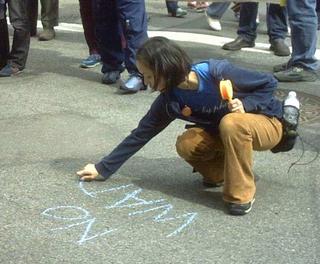
I see by the ever-handy site meter that last week's ruminations on David Kellogg's proposed map of contemporary poetry generated a huge spike in hits to this site of the sort not seen since the Contingent Manifesto was posted back in June. If the responses out there on other blogs are any indication, the response seems to have been one part glee at the smashing of old Langpo idols, one part enthusiasm about the possibilities of Kellogg's method, and one part glowering hostility. Great! I mean, if my poems could generate destructive glee, creative enthusiasm, and seething disdain in equal measure, I'd know for sure that I was on to something.
So, in the Kelloggian spirit of classification, here's a breakdown of responses:
1. The Children of the Stagnant Revolution Revolt
Kevin Andre Elliot (whose disdain for the Avant-Post/School of Quietude dichotomy launched a thousand posts) and Natalia Cecire both weigh in with posts about Kellogg's model being an improvement on the Sillimanic dichotomy. I know, I know, Ron's not the sole proprietor of the dismal dichotomy, but he's the primary propagator, and he's singled out by Natalia as something of an obsessive:
I must say, I do think Ron Silliman is ever-so-slightly on the obsessed side when it comes to this issue. Half his posts seem to say "OMG SoQ alert!!!!" about one book or another. I'm as unimpressed with Billy Collins as the next person with a pulse, but could we relax?
I want to state for the record that I think Bob Hass, Brenda Hillman, and Lyn Hejinian are all fantastic human beings and excellent poets.
What's interesting here, I think, is that both Kevin and Natalia are grad students, and watching their reactions to this little bit of resistance to the Silliman line seems just a bit like watching those kids in Berlin back in '89, when the wall came down and all the old statues that the aged revolutionaries had erected to themselves and their ever-advancing, ever-underdoggish revolution were pulled down. Okay, yeah, there's a difference of proportion, but you get the drift: a rising generation sees the rhetoric of the old former-revolutionaries differently than do the surviving firebrands themselves. I mean, I doubt Silliman and Company will ever feel like the establishment figures they have, in large measure, become, no matter how many research university posts they hold, no matter how many citations they get in the MLA database. And so they'll talk like they're the Che Guevaras of poetry, when for people younger than I am, they can seem more like the Fidel Castros (that's Fidel circa the Elian Gonzales imbroglio, not Fidel back when he looked cool in camo and the CIA kept trying to ice him). Or better yet: they come across like Leonid Brezhnev, peering out wanly from behind his medals and ghastly eyebrows, reviewing the parade of loyal Post-Avants in the Revolutionary Square below.
Natalia gives us a further glimpse into the Soul of the Grad Student when, after dismissing the Avant/Quietude dichotomy, she tells us:
If there's a dichotomy I really care about, it's "willing to be on my committee"/"unwilling to be on my committee."
By the way, I kind of like the sound of "Avant-Quietude." I hearby release all copywrite from the term, in the event anyone wants to apply it to some unfortunate poet or other (preferably someone who's been on the cover of the American Poetry Review).
2. The Romantic Anti-Structuralist Institute of Providence, Rhode Island Registers an Objection
This is the powerful research institute headed up by Henry Gould. The fact that Henry's the only member does nothing to reduce the power of the institute. I remember, from the old days of the Buffalo Poetics List, that a fair fight would be something like Henry vs. All the Rest of Us. Henry maintains that the Kellogg grid isn't really an improvement on the tired/misleading dichotomy of Avant and Quietude, because even in with the added dimensions of the Kellogg model,
Poetry is assumed to be this product which flows out of culture in measurable quantities. You can establish fixed criteria for assigning individual pieces of the product to a grid : ie., "tradition" and "innovation" are already known & defined, "self" and "community" are items you can abstract without too much difficulty from any particular portion of the GNPP (Gross National Poetry Product). Voila : your poet is assigned a critical niche in the Standard Schema.
He goes on to describe the complications this model runs into:
But what if the patterns of formative imitation which poets utilize are exactly the same - whether you're in either of the so-called camps? Innovators are imitating their 20th-century models; traditionalists are doing likewise. Both are claiming the mantle of tradition (the traditions of new & old, respectively). Add a further twist : what if the innovators claim to be new by going back to older models (epics, Native American songs, collective poetics, performance art, etc.) in order to be "new"? What if the models of the so-called traditionalists (rhymed iambic couplets, say) are of more recent provenance than those of the innovators (say, free-verse anaphoric lines)?
You know, he's got a point. I tried to investigate something like this at one of the Modernist Studies Association conferences a few years ago, up in Madison. I took Joe Francis Doerr's book Order of the Ordinary as an example of a book that could be claimed from every pole of every axis on Kellogg's grid at once. For me, this was a sign of Doerr's interest (gawd, but he's underappreciated) more than it was a sign of the limits of Kellogg's model, but I take Henry's point.
I think, though, that there's more to Henry's objections than this. He writes, for example, that "The uniqueness of interesting poetry swallows up every proposed schema." An interesting point, because a very Romantic one. I mean, the singularity of genius, the unclassifiability of truly impressive aesthetic experience — it all sounds a bit like a riff on Coleridge's discussion of organic form. Sometimes I think that, for all of his critical intellect, Henry is in the end a "we murder to dissect" guy, especially if the dissection comes out of a structuralist tradition, which he seems to see as mechanical (I'm disappointed that he took down a post that made fun of models like Kellogg's by pretending to sell a machine for the assessing of poetry — even though it took a shot at a model I admire, I thought it made a powerful objection with good humor).
So let's call Henry's objection the latest chapter in the ongoing battle of the Romantics against the Enlightenment, now in year 216, with no sign of either side wearing down.
3. Brave Men of Science Discover a Third Dimension
Joshua Clover, in his persona as Jane Dark (which I like, but don't exactly get), goes all mad-scientist on the Kellogg model and takes it to the next level, adding another dimension for a three-dimensional system of Cartesian co-ordinates:

His third dimension locates a given poet's degree of partisan, polemical fever. What does this mean? He (she? what should one call a male poet's femal persona?) explains:
For example, in the cross as currrently constituted, we get a "tradition/innovation" axis: per Kellogg, Poetry that, for example, emphasizes its continuity with the past (such as the New Formalist work of poets like Dana Gioia) represents a position close to the “tradition” value-identification. In contrast, avant-garde writing represents a position near the “innovation” value-identification.
Strikingly, though Gioia and Silliman e.g. find themselves at antipodes in this scheme, they have a deep commonality: their shared interest in impressing their own sense of value on the field via their writings, talks, position-takings, jobs, blogs, blurbs, etc. Discursively, they are both proselytizers; Silliman and Gioia would find themselves sitting on the same branch, staring down its full distance to Andrew Joron and Karen Volkman in the great distance.
Pretty sharp, eh? But just when you think things have gotten as clever as they're going to get, someone with some actual knowledge of co-ordinate systems comes in and makes you feel like the neophyte you are. This happened to me when I ran across Jeffrey Bahr's take on the Kellogg model. Bahr, who is no mere poet but a poet and and engineer (and therefore equipped with math and stats chops you and I can only marvel at) says, with what I imagine to be a slightly weary sigh at the follies of humanists,
As I've mentioned before, there is a statistical procedure for teasing out underlying axes of discrimination (multidimensional scaling), but it would take getting lots of input from poets in the form of poet-pair ranks.
I'd like to know more about this statistical procedure, which remains murky to my qualitative mind. Perhaps equipped with such forbidden knowledge, I will on some dark and stormy night ascend a windy trail to a dark tower on a mountaintop and, with the able help of my student assistant Igor, I'll fire up the Jacob's Ladder and the various machines that go ping and wait for a lightening strike, at which point I'll throw a mighty lever and bring to life the Paradigm that will Explain Poetry! No — Igor no! Not now! We don't know the ramifications! We've meddled in things meant for God alone! Too late! Nooo-ooooo-oooo! Igor! I am so very afraid!













